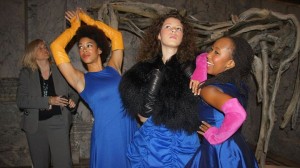I have often wondered why more artists don’t use their own body in the transmission of their ideas, their thoughts and, indeed, of themselves. The body strikes me as an important medium for moving from and beyond the individual experience to a realm of complex art that can engage other people meaningfully. Perhaps, I thought, there has to be some native (yet often elusive) intimacy with the body to see it in its many identities as the hand, the paintbrush and the painting. All artists of course must use their body in some way — dancers particularly are renowned for their mastery of the body and of movement. But to take the body outside of the recognizable classic art forms in the performance of life and ideas has long been considered a peripheral activity.

In this quarter’s class, Dance 67: Being S(c)ene: Dance, Fashion and Art as Exhibition, we have brought the periphery to the center. We have in fact decorated the center with many elements of the periphery. We have centralized the body as its own piece of art situated among — and in productive dialogue with — other famous and familiar art works. We have centralized ourselves as present and active. We have set ourselves in the space of the museum to see and be seen. And how wonderful it has been to establish ourselves at home in the museum and at home in the self! We have not been practicing an oppositional art; indeed, the desire has been to be comfortable in an imposing space. The process has been hugely important in and of itself and has happily drawn upon dance and theatre and literature. The artist Carrie Mae Weems, a retrospective of whose work is currently on display at the Cantor Arts Center, specifically has been a fantastic inspiration for our process and our work too. The striking and informative presence of herself in her work, and her ability to discourse beyond and yet incorporating minority experience, has been a guiding example.
We have been in dialogue, and the overwhelming attendance to our installation showed that other people are interested in the conversation. To have people present — finally — in what had become a home, after so much work within our group, was an arresting and affirming experience. Their presence helped me realize that our art hadn’t been complete until they arrived. By walking into the museum space we had claimed as our creative space, they immediately became a part of the picture — as was our hope. And I hope that the art in place was imbued by our presence in the museum as performers/spectators, that the art came alive to everyone as dynamic, rather than static objects of our seeing. And, in the words of a friend, “Perhaps it’s possible too that the audience felt themselves as performers, on a stage, in a dialogue with themselves, the art and others who have walked through the space, rather than just as people sliding through empty space with things on the wall.” I hope so. In an unsurprising way, I realized I had been waiting for their spectatorship: The audience participants looking meant that there was something there to be seen. That was great. I really felt it; what it is to perform in oneself, to others, in a complicated but essential way.
For me, it was and is about communicating with others and with yourself. I come away from the process and the performance knowing that you can communicate intelligently using your self in performance art. That you can learn from embodied art an assuredness of the self that informs positively your communications in the world. That you can be involved with the self in a way that is not self-involved. (Not like Jay Z.) The body is already such a complicated and much undefined site; how irresistible I find the endeavor of delving it, working it and projecting with intention and agency what I find — and create — there.
